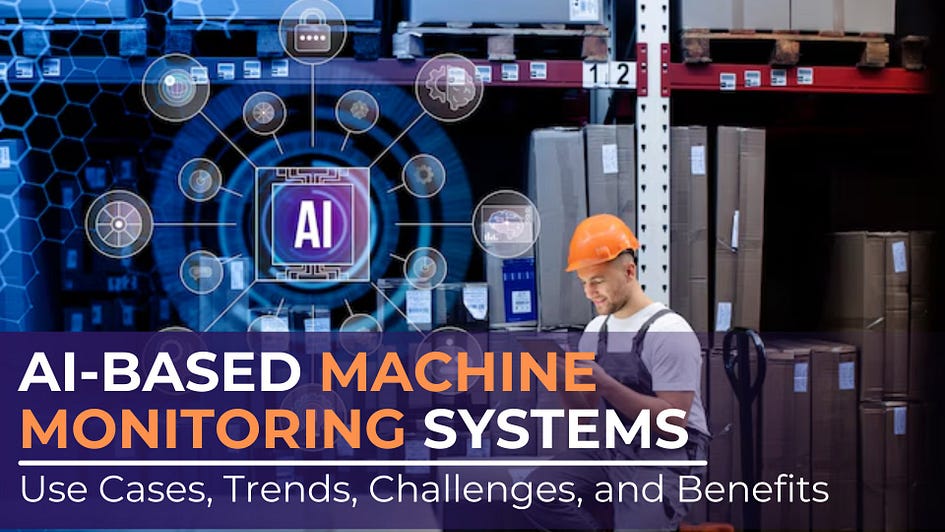
In recent years, Artificial Intelligence (AI) has become a cornerstone of Industry 4.0, enabling smarter, more efficient operations across industries. One of the most promising applications is AI-based machine monitoring systems. These systems leverage advanced algorithms and real-time data analysis to optimize equipment performance, predict failures, and improve operational efficiency. In this blog, we explore the use cases, trends, challenges, and benefits of AI-driven machine monitoring systems.
What is AI-Based Machine Monitoring?
AI-based machine monitoring refers to the use of artificial intelligence and machine learning technologies to oversee and assess the performance of industrial equipment in real time. Traditional monitoring systems often rely on manual data collection and rule-based automation. AI-based systems, however, harness vast amounts of data from sensors, controllers, and other industrial components to make predictive and autonomous decisions.
With these systems, businesses can identify issues before they cause downtime, reduce human errors, and enhance productivity. The technology typically uses predictive analytics, anomaly detection, and real-time monitoring, providing insights that can preempt costly breakdowns or inefficiencies.
Use Cases of AI-Based Machine Monitoring Systems
- Predictive Maintenance One of the most common applications of AI-based monitoring is predictive maintenance. AI systems analyze data from machinery sensors, such as temperature, vibration, and pressure, to predict when equipment will likely fail. This allows maintenance teams to service the machines before breakdowns occur, reducing unplanned downtime and extending the equipment’s life cycle.
- Quality Control AI can monitor production quality by analyzing data from various stages of the manufacturing process. It can detect defects or deviations in real-time, improving product consistency and reducing waste. AI systems can automatically adjust machine parameters to ensure quality standards are maintained.
- Energy Efficiency Optimization AI-driven monitoring systems can track and analyze energy consumption patterns across machines, helping to identify inefficiencies. By optimizing machine performance and reducing energy waste, these systems contribute to significant cost savings and more sustainable operations.
- Supply Chain Management Machine monitoring systems can be integrated into supply chain management to improve scheduling, inventory management, and demand forecasting. AI can analyze machine performance data to predict delays or bottlenecks, allowing businesses to adapt their supply chains accordingly.
- Remote Monitoring In industries like oil and gas, AI-based machine monitoring enables remote tracking of equipment performance. It can be especially useful for monitoring machinery in geographically remote or hazardous environments, reducing the need for on-site personnel and increasing operational safety.
Trends in AI-Based Machine Monitoring
- Edge Computing Edge computing, where data processing occurs at or near the data source, is becoming increasingly common in AI-based machine monitoring. This reduces latency and allows for real-time decision-making, even when connected to cloud-based analytics.
- Integration with IoT AI systems is often integrated with the Internet of Things (IoT), enabling seamless data collection from various devices and sensors. The fusion of AI and IoT accelerates data-driven decision-making, making industrial operations smarter and more interconnected.
- Adoption of Digital Twins Digital twins — virtual replicas of physical systems — are becoming a significant trend. AI monitors the digital twin to simulate different operational conditions and predict how the real machine will perform under various scenarios, further enhancing predictive maintenance and optimization.
- AI in Small and Medium Enterprises (SMEs) While AI adoption in machine monitoring was once reserved for large industries, SMEs are now increasingly adopting these technologies due to decreasing costs and easier implementation. This democratization is driving the expansion of AI-based monitoring across sectors.
Challenges of AI-Based Machine Monitoring
- Data Quality and Availability AI algorithms rely heavily on high-quality, clean data. If the data is incomplete, noisy, or inconsistent, it can lead to inaccurate predictions and decisions. Ensuring a continuous stream of reliable data can be challenging, especially in older industries with legacy systems.
- Implementation Costs The initial setup of AI-based monitoring systems, including hardware, software, and training, can be expensive. For small companies, the cost can be a significant barrier to entry. However, as the technology matures, costs are expected to decrease over time.
- Integration with Legacy Systems Many industries still rely on legacy systems that were not designed for AI or real-time data integration. Retrofitting these systems can be complex, time-consuming, and costly, requiring specialized expertise.
- Workforce Training AI-based monitoring requires new skill sets, such as data analytics, AI model management, and machine learning operations. Employees need to be trained to work effectively with these systems, which can be a time-consuming and resource-intensive process.
Benefits of AI-Based Machine Monitoring Systems
- Reduced Downtime Predictive maintenance helps prevent unexpected equipment failures, significantly reducing downtime. This not only improves productivity but also enhances overall operational efficiency.
- Cost Savings By identifying inefficiencies and optimizing machine performance, AI-based monitoring reduces energy consumption and maintenance costs. Predictive maintenance also minimizes the need for emergency repairs, saving on labor and parts.
- Enhanced Decision-Making AI provides actionable insights from vast amounts of data that would be impossible for humans to process manually. These insights help organizations make data-driven decisions, improving operational planning and execution.
- Improved Safety AI-based systems can detect potential safety hazards in machinery before they escalate, protecting workers and preventing accidents. Remote monitoring capabilities further reduce the need for human presence in dangerous environments.
Conclusion
AI-based machine monitoring systems represent a transformative technology that enhances operational efficiency, reduces costs, and improves safety across industries. While challenges such as data quality and implementation costs exist, the long-term benefits, including predictive maintenance, energy optimization, and quality control, make AI-driven machine monitoring a valuable investment for businesses looking to stay competitive in the era of Industry 4.0. As the technology evolves, the barriers to entry will lower, making it more accessible to industries of all sizes.
Comments